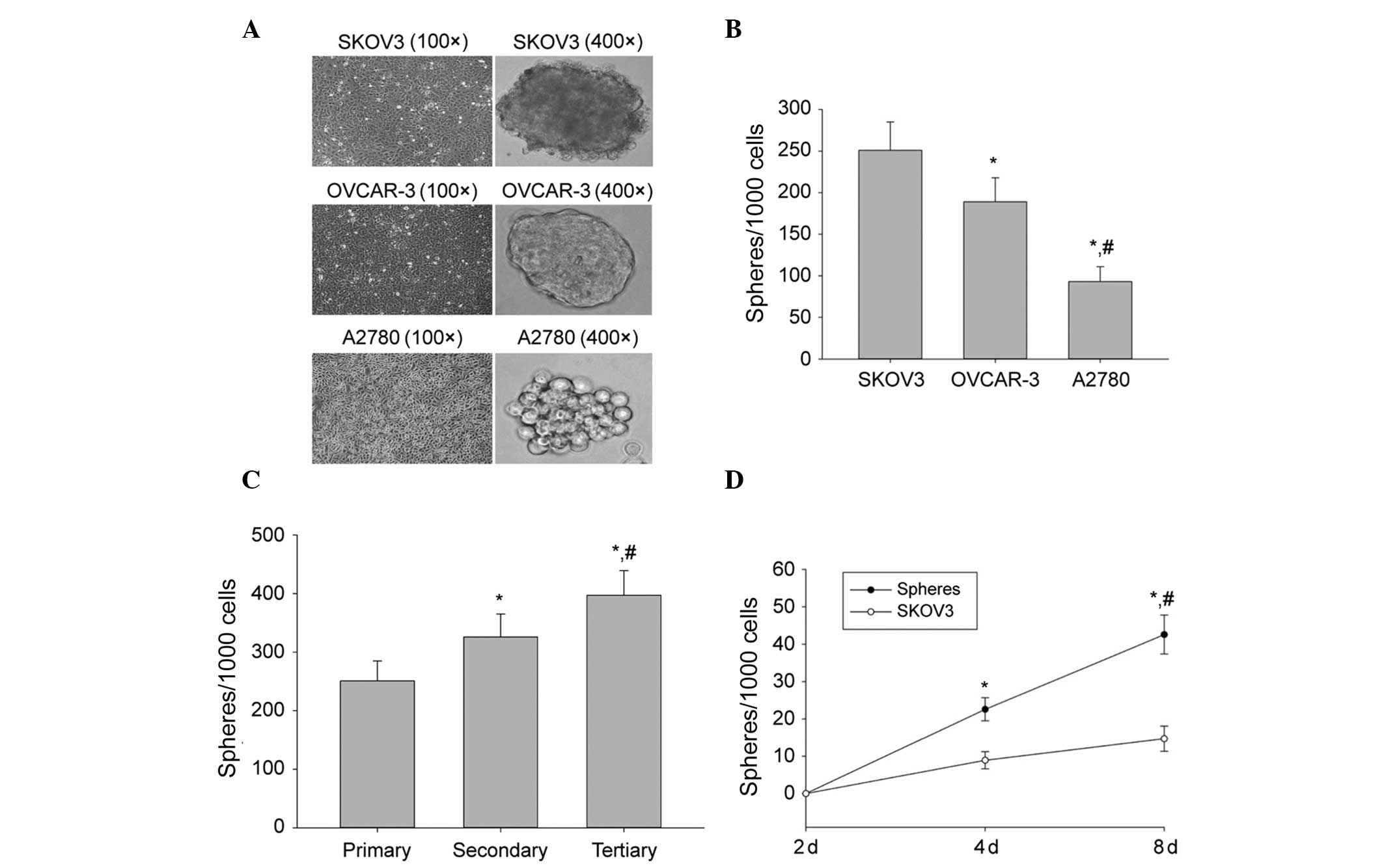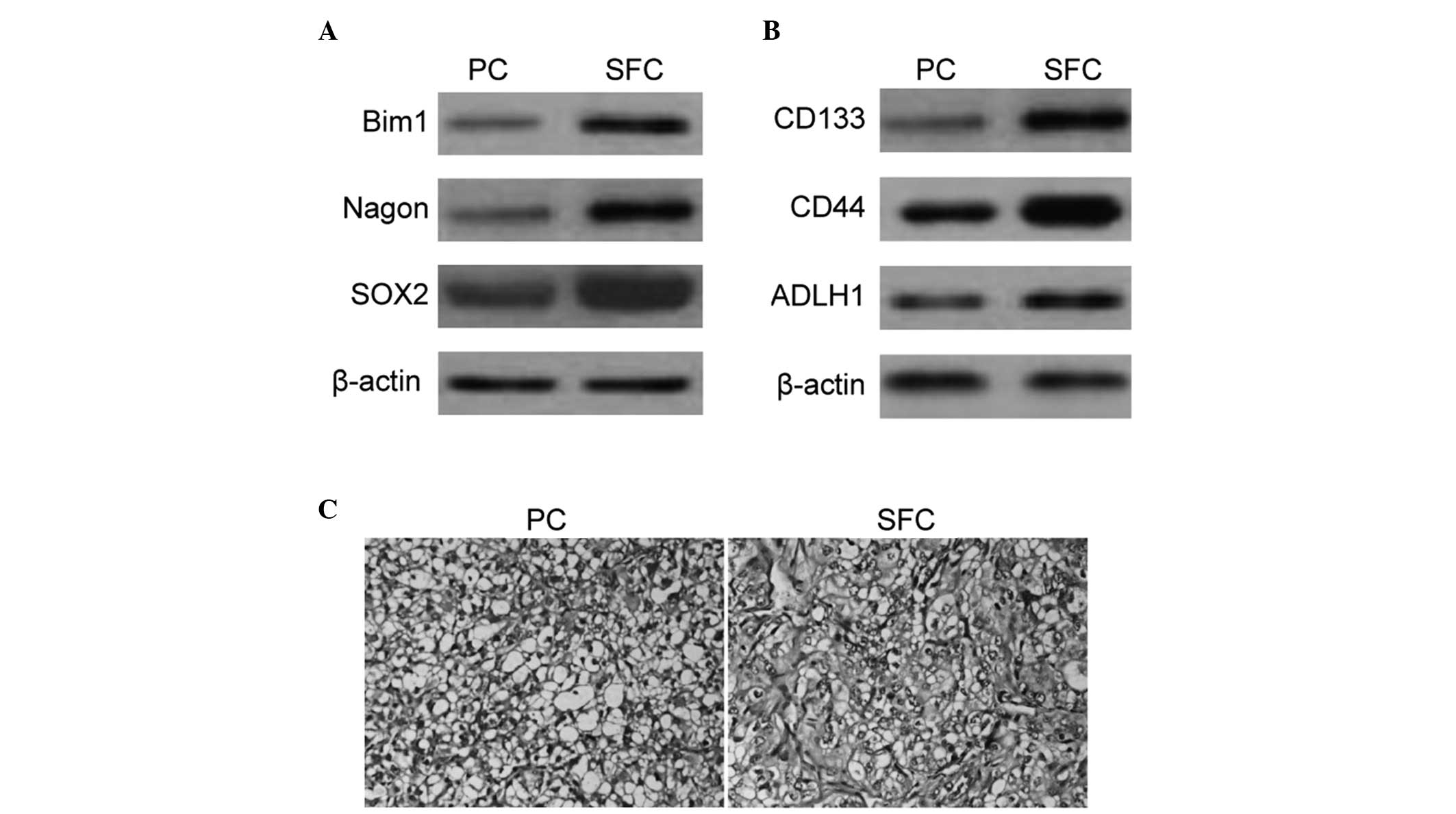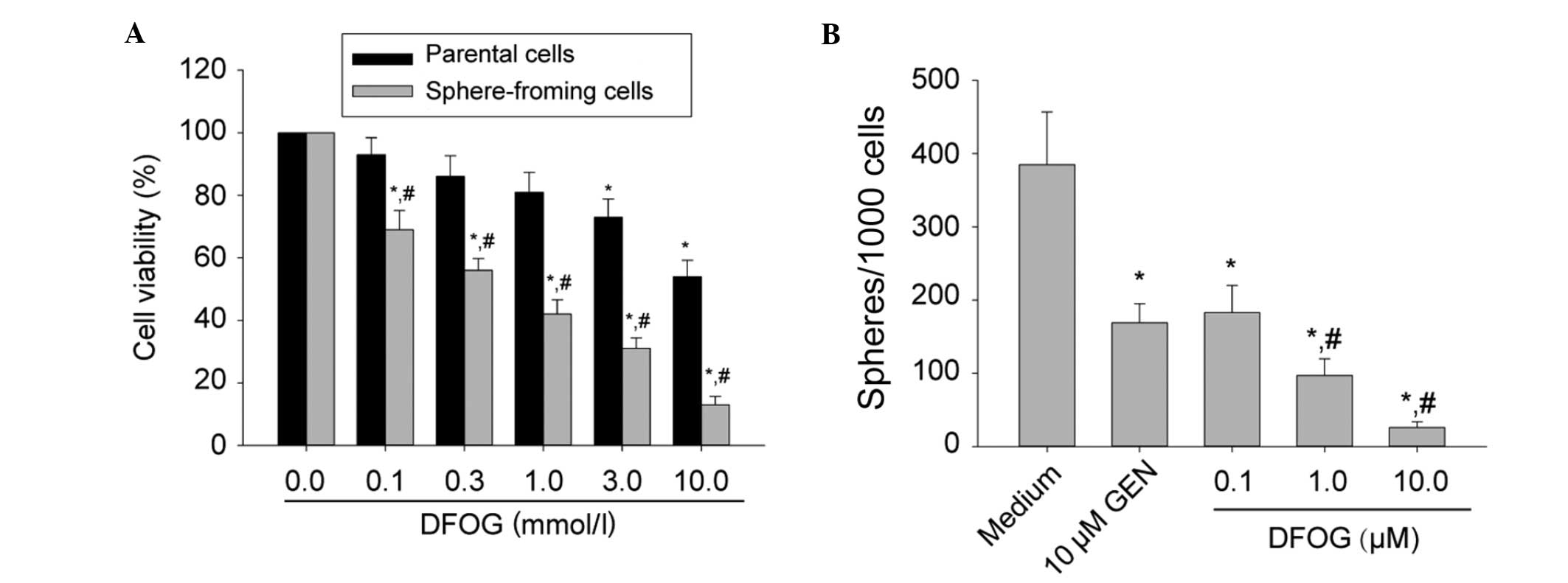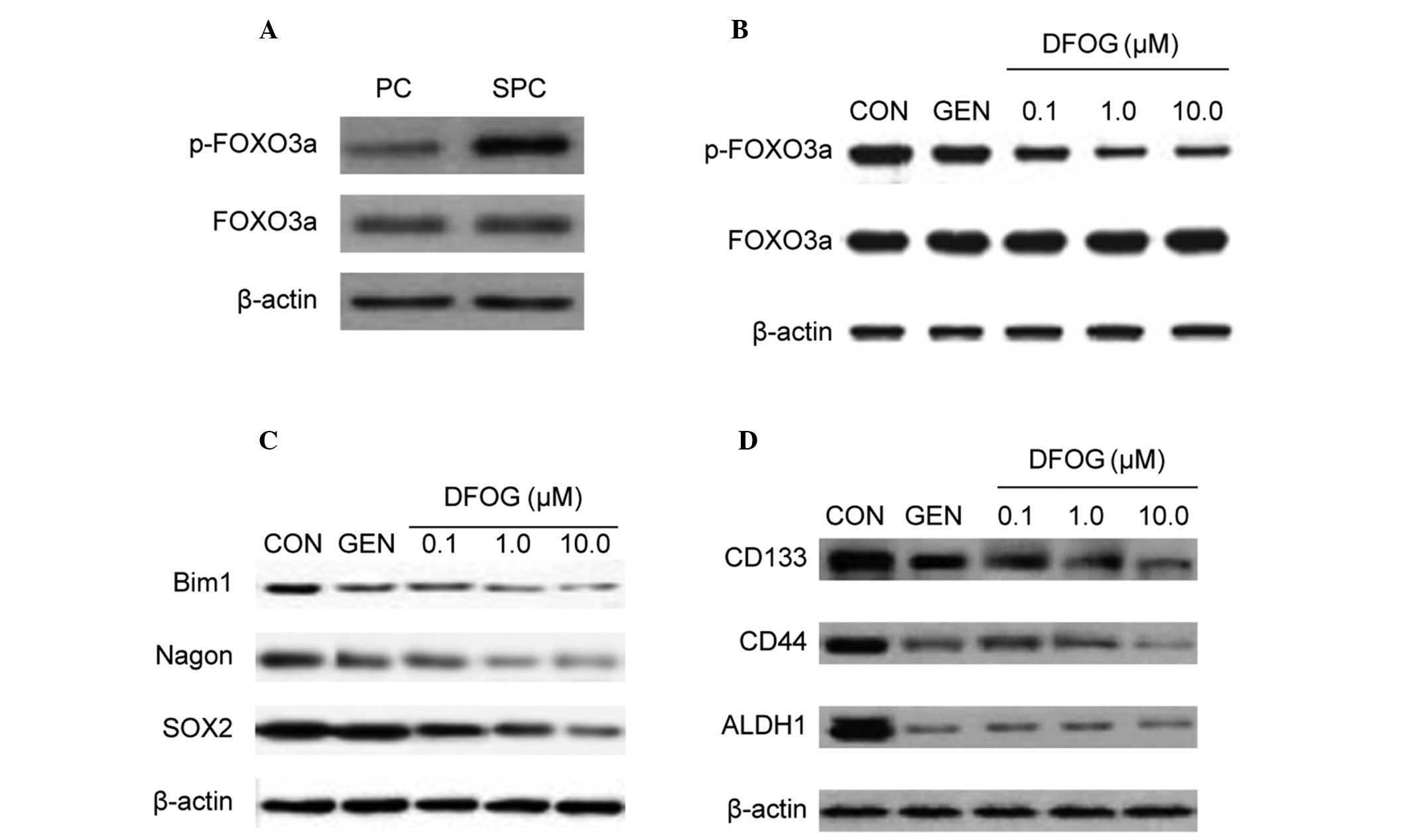|
1
|
Jemal A, Center MM, Ward E and Thun MJ:
Cancer occurrence. Methods Mol Biol. 471:3–29. 2009. View Article : Google Scholar
|
|
2
|
Schwartz PE: Current diagnosis and
treatment modalities for ovarian cancer. Cancer Treat Res.
107:99–118. 2002.PubMed/NCBI
|
|
3
|
Almanaa TN, Geusz ME and Jamasbi RJ:
Effects of curcumin on stem-like cells in human esophageal squamous
carcinoma cell lines. BMC Complement Altern Med. 12:1952012.
View Article : Google Scholar : PubMed/NCBI
|
|
4
|
Quitschke WW: Curcuminoid binding to
embryonal carcinoma cells: reductive metabolism, induction of
apoptosis, senescence, and inhibition of cell proliferation. PLoS
One. 7:e395682012. View Article : Google Scholar
|
|
5
|
Chen SF, Nieh S, Jao SW, et al: Quercetin
suppresses drug-resistant spheres via the p38 MAPK-Hsp27 apoptotic
pathway in oral cancer cells. PLoS One. 7:e492752012. View Article : Google Scholar : PubMed/NCBI
|
|
6
|
Lee CH, Hong HM, Chang YY and Chang WW:
Inhibition of heat shock protein (Hsp) 27 potentiates the
suppressive effect of Hsp90 inhibitors in targeting breast cancer
stem-like cells. Biochimie. 94:1382–1389. 2012. View Article : Google Scholar : PubMed/NCBI
|
|
7
|
Montales MT, Rahal OM, Kang J, et al:
Repression of mammosphere formation of human breast cancer cells by
soy isoflavone genistein and blueberry polyphenolic acids suggests
diet-mediated targeting of cancer stem-like/progenitor cells.
Carcinogenesis. 33:652–660. 2012. View Article : Google Scholar
|
|
8
|
Bao B, Wang Z, Ali S, et al:
Over-expression of FoxM1 leads to epithelial-mesenchymal transition
and cancer stem cell phenotype in pancreatic cancer cells. J Cell
Biochem. 112:2296–2306. 2011. View Article : Google Scholar : PubMed/NCBI
|
|
9
|
Bao B, Wang Z, Ali S, et al: Notch-1
induces epithelial-mesenchymal transition consistent with cancer
stem cell phenotype in pancreatic cancer cells. Cancer Lett.
307:26–36. 2011. View Article : Google Scholar : PubMed/NCBI
|
|
10
|
Rodova M, Fu J, Watkins DN, Srivastava RK
and Shankar S: Sonic hedgehog signaling inhibition provides
opportunities for targeted therapy by sulforaphane in regulating
pancreatic cancer stem cell self-renewal. PLoS One. 7:e460832012.
View Article : Google Scholar : PubMed/NCBI
|
|
11
|
Kallifatidis G, Labsch S, Rausch V, et al:
Sulforaphane increases drug-mediated cytotoxicity toward cancer
stem-like cells of pancreas and prostate. Mol Ther. 19:188–195.
2011. View Article : Google Scholar : PubMed/NCBI
|
|
12
|
Rausch V, Liu L, Kallifatidis G, et al:
Synergistic activity of sorafenib and sulforaphane abolishes
pancreatic cancer stem cell characteristics. Cancer Res.
70:5004–5013. 2010. View Article : Google Scholar : PubMed/NCBI
|
|
13
|
Li Y, Zhang T, Korkaya H, et al:
Sulforaphane, a dietary component of broccoli/broccoli sprouts,
inhibits breast cancer stem cells. Clin Cancer Res. 16:2580–2590.
2010. View Article : Google Scholar : PubMed/NCBI
|
|
14
|
Chaudhuri D, Orsulic S and Ashok BT:
Antiproliferative activity of sulforaphane in Akt-overexpressing
ovarian cancer cells. Mol Cancer Ther. 6:334–345. 2007. View Article : Google Scholar : PubMed/NCBI
|
|
15
|
Chen D, Pamu S, Cui Q, Chan TH and Dou QP:
Novel epigallocatechin gallate (EGCG) analogs activate
AMP-activated protein kinase pathway and target cancer stem cells.
Bioorg Med Chem. 20:3031–3037. 2012. View Article : Google Scholar : PubMed/NCBI
|
|
16
|
Nishimura N, Hartomo TB, Pham TV, et al:
Epigallocatechin gallate inhibits sphere formation of neuroblastoma
BE(2)-C cells. Environ Health Prev Med. 17:246–251. 2012.
View Article : Google Scholar
|
|
17
|
Xiang HL, Liu F, Quan MF, Cao JG and Lv Y:
7-difluoromethoxyl-5,4′-di-n-octylgenistein inhibits growth of
gastric cancer cells through downregulating forkhead box M1. World
J Gastroenterol. 18:4618–4626. 2012.
|
|
18
|
Ning Y, Li Q, Xiang H, Liu F and Cao J:
Apoptosis induced by 7-difluoromethoxyl-5,4′-di-n-octyl genistein
via the inactivation of FoxM1 in ovarian cancer cells. Oncol Rep.
27:1857–1864. 2012.PubMed/NCBI
|
|
19
|
Sunayama J, Sato A, Matsuda K, et al:
FoxO3a functions as a key integrator of cellular signals that
control glioblastoma stem-like cell differentiation and
tumorigenicity. Stem Cells. 29:1327–1337. 2011.PubMed/NCBI
|
|
20
|
Shiota M, Song Y, Yokomizo A, et al:
Foxo3a suppression of urothelial cancer invasiveness through
Twist1, Y-box-binding protein 1, and E-cadherin regulation. Clin
Cancer Res. 16:5654–5663. 2010. View Article : Google Scholar : PubMed/NCBI
|
|
21
|
Wu KJ and Yang MH: Epithelial-mesenchymal
transition and cancer stemness: the Twist1-Bmi1 connection. Biosci
Rep. 31:449–455. 2011. View Article : Google Scholar : PubMed/NCBI
|
|
22
|
Dubrovska A, Kim S, Salamone RJ, et al:
The role of PTEN/Akt/PI3K signaling in the maintenance and
viability of prostate cancer stem-like cell populations. Proc Natl
Acad Sci USA. 106:268–273. 2009.
|
|
23
|
Reya T, Morrison SJ, Clarke MF and
Weissman IL: Stem cells, cancer, and cancer stem cells. Nature.
414:105–111. 2001. View
Article : Google Scholar : PubMed/NCBI
|
|
24
|
Kakarala M and Wicha MS: Implications of
the cancer stem-cell hypothesis for breast cancer prevention and
therapy. J Clin Oncol. 26:2813–2820. 2008. View Article : Google Scholar : PubMed/NCBI
|
|
25
|
Sakariassen PØ, Immervoll H and Chekenya
M: Cancer stem cells as mediators of treatment resistance in brain
tumors: status and controversies. Neoplasia. 9:882–892.
2007.PubMed/NCBI
|
|
26
|
Tang C, Chua CL and Ang BT: Insights into
the cancer stem cell model of glioma tumorigenesis. Ann Acad Med
Singapore. 36:352–357. 2007.PubMed/NCBI
|
|
27
|
Lippman ME: High-dose chemotherapy plus
autologous bone marrow transplantation for metastatic breast
cancer. N Engl J Med. 342:1119–1120. 2000. View Article : Google Scholar : PubMed/NCBI
|
|
28
|
Williams SD, Birch R, Einhorn LH, Irwin L,
Greco FA and Loehrer PJ: Treatment of disseminated germ-cell tumors
with cisplatin, bleomycin, and either vinblastine or etoposide. N
Engl J Med. 316:1435–1440. 1987. View Article : Google Scholar : PubMed/NCBI
|
|
29
|
Liu T, Cheng W, Lai D, Huang Y and Guo L:
Characterization of primary ovarian cancer cells in different
culture systems. Oncol Rep. 23:1277–1284. 2010.PubMed/NCBI
|
|
30
|
Ma L, Lai D, Liu T, Cheng W and Guo L:
Cancer stem-like cells can be isolated with drug selection in human
ovarian cancer cell line SKOV3. Acta Biochim Biophys Sin
(Shanghai). 42:593–602. 2010. View Article : Google Scholar : PubMed/NCBI
|
|
31
|
Li Y, Chen H, Hardy TM and Tollefsbol TO:
Epigenetic regulation of multiple tumor-related genes leads to
suppression of breast tumorigenesis by dietary genistein. PLoS One.
8:e543692013. View Article : Google Scholar : PubMed/NCBI
|
|
32
|
Regenbrecht CR, Jung M, Lehrach H and
Adjaye J: The molecular basis of genistein-induced mitotic arrest
and exit of self-renewal in embryonal carcinoma and primary cancer
cell lines. BMC Med Genomics. 1:492008. View Article : Google Scholar : PubMed/NCBI
|















